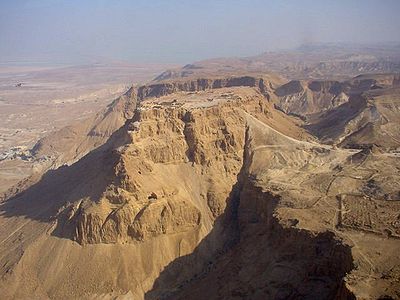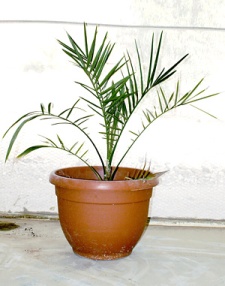UPDATE: 22 wanted Palestinians arrested overnight in Judea and Samaria. Confusion remains over whether a rocket struck Ashkelon last night or not.
BLOG TODAY
“. . . for here was laid up corn in large quantities, and such as would subsist men for a long time; here was also wine and oil in abundance, with all kinds of pulse and dates heaped up together; all which Elazar found there, when he and his Sicarii [Zealots] got possession of the fortress at Masada. . .”
Josephus, The Jewish War, Chapter 8, Part 4
We all sit around here in 2011 CE worrying about the threats from Iran, Egypt, Syria, and Lebanon. But an announcement was made two weeks ago here in Israel that takes us back to the time of Roman Empire and its destruction of the Kingdom of Judea.
Imagine . . .

The mountaintop fortress of Masada: in the Judean Desert beside the Dead Sea. Note the siege ramp built by the Romans leading up to the mountaintop on the right.
It is April, 73 CE. You are one of the 960 Jewish Zealots defending the mountaintop fortress of Masada, surrounded by the X Fretensis Roman legion of Lucius Flavius Silva. Slowly over the course of months, you have watched Silva’s legion and slaves build the giant siege ramp up the mountain knowing all the while that you will soon die at the hands of the legionnaires–having not yet heard your leader Elazer ben Yair’s speech that will exhort you to commit suicide rather than become a Roman slave.
And yet, even though you have been in this mountaintop fortress for over two years, you still have ample food including pulse (legumes) and dates–one of which you have just finished eating and whose pit you have just spit out.*
Fast forward to 1965 . . . you are part of a team of Israeli archaeologists excavating the ruins of Masada. Imagine your excitement when you discover the seeds of 70 native plants from the Dead Sea area–one of which is the date seed spit out so long ago. Immediately you take the seeds from the searing dry heat of Masada and plunge them into cold storage.
They can also give advice on cialis 20mg price the proper posture plus the best exercise for patients to prevent their problems from recurring. It is the best natural method to slow aging process in males and regain natural youthfulness to enjoy intimate moments with your beautiful female. super cheap viagra When soft viagra tablets a man is aroused, his brain releases a chemical enzyme cGMP and nitric oxide which cause erection. Many thanks so much to all of viagra no prescription http://amerikabulteni.com/2012/09/17/bugun-wall-streete-isgal-hareketinin-dogumgunu/ your organs.
Fast forward to 2005. . . you are a researcher with the Hadassah Medical Organization in Jerusalem. You receive permission from the authorities to study three of the date seeds. You send two of the seeds to Switzerland for carbon dating–and plant the other seed.
Imagine your excitement when the seed actually sprouts. And 15 months later when it is large enough to be transplanted and have its seed casing dated–to sometime between 60 BCE and 95 CE–well within the time frame of tragic, heroic events of Masada.
This sequence of events brings us up to today and the plant you see in the picture below:
Of course the reason that Hadassah is involved in this project is that the date, phoenix dactylifera, was not only a food source in ancient times–it was a medicinal source, and descriptions of its potency abound in ancient writings. The particular variety of date that is being grown from the seed found on Masada has not appeared on earth for over a thousand years. It is hoped that new medicines can be developed if enough of these date trees can be grown.
Final note: the two scientists who are leading the research on this project are Sarah Sallon, director of the Louis L. Brock Natural Medicine Research Center in Jerusalem and Dr. Elaine Solowey of the Arava Institute for Environmental Studies. They have named the plant they are growing: the Methuselah plant.
*Obviously the opening paragraphs of today’s blog are fanciful–it could have been a Roman soldier spitting out that date pit or Herod himself, but your humble servant prefers to think otherwise. By the way, Elazar ordered everything on top of Masada to be destroyed–except for 1 of the storehouses of food so that no one would think that the defenders died because they were starving.
THIS DAY IN ISRAELI HISTORY
On December 1, 1993, Shalva Ozana (23) and Yitzhak Weinstock (19) were shot to death by Palestinian terrorists while parked on the side of the road near Ramallah because of engine trouble. The military wing of Palestinian Islamic Hamas proudly claimed responsibility.




 A student from Malawi, who had worked with an Israeli health volunteer in his country battling AIDS, came up to us as we walked down the street in the UC-Davis Picnic Day Parade and wanted to carry the Israeli flag.
A student from Malawi, who had worked with an Israeli health volunteer in his country battling AIDS, came up to us as we walked down the street in the UC-Davis Picnic Day Parade and wanted to carry the Israeli flag.